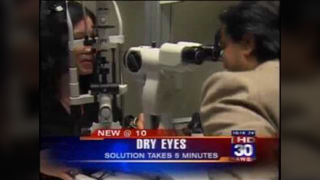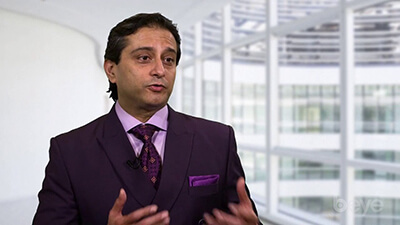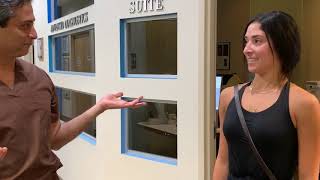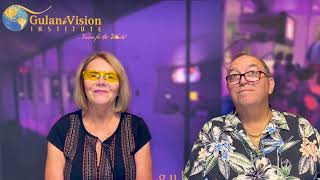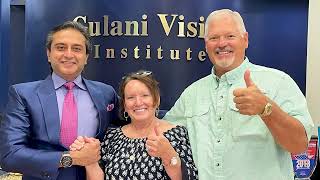The World's Leading Dry Eye Specialist in Jacksonville
Dry eyes affects millions of patients worldwide and could present with mild to severe discomfort in the form of a relentless disorder. For over 3 decades, Dr. Gulani’s custom-designed dry eye management using his proprietary m.o.i.s.t.Ⓡ therapy has helped thousands of patients globally not only in their symptoms, but also in many cases, improving their vision and function. Dr. Gulani is also a world resource for patients seeking second opinions and corrections of their failed dry eye treatments and complications from dry eye centers and eye surgical facilities elsewhere. By custom-designing his approach to dry eye patients using his innovative techniques and technologies as part of his m.o.i.s.t.Ⓡ therapy spectrum, Dr. Gulani has raised Dry Eye care to an ART.
Understanding Dry Eye Syndrome
Dry eye syndrome is a common yet often misunderstood condition that affects millions of people worldwide. Characterized by a full spectrum of inadequate tear production or poor-quality tears, to abnormal distribution, or excessive loss/evaporation of tears, dry eye syndrome leads to uncomfortable symptoms, including redness, irritation, blurred vision, and a gritty feeling in the eyes. When the tear film fails to provide sufficient lubrication and protection, the eye’s surface can become damaged, resulting in persistent discomfort and, in severe cases, vision impairment. Addressing dry eye syndrome is essential, as untreated cases can significantly impact a person’s quality of life.
The Importance of Tears and Tear Film Stability
Tears are composed of three layers—a mucous layer, a watery layer, and an oily layer—each with a unique function.
– Mucin Layer: Helps tears stick to the eye and also spread uniformly across the eye’s surface.
– Aqueous Layer: The main tear film layer with all nutrients provides hydration and essential nutrients.
– Lipid Layer: Acts as a surfactant and prevents rapid evaporation, maintaining moisture.
Dry eye syndrome occurs when any of these layers are out of balance, leading to dryness, irritation, and potential damage. This could mean inadequate tear production, poor-quality tears, or an issue with tear drainage. When the tear film fails to provide adequate moisture and protection, the eye becomes vulnerable to irritation and potential damage.
Symptoms and Causes of Dry Eye Syndrome
Dry eye symptoms can vary from mild to severe and may include burning, stinging, sensitivity to light, and excessive tearing. While some individuals experience intermittent symptoms, others struggle with chronic discomfort that disrupts their daily activities. The condition may be caused by a variety of factors, such as aging, hormonal changes, environmental exposure, and long periods of screen time. Causes vary and include aging, hormonal changes, environmental factors, extended screen time, and certain systemic medical conditions like hypothyroidism, rheumatoid arthritis, Sjogren’s syndrome or medications, including common anti allergic medications. Understanding these underlying causes is key to choosing the most effective treatment approach.
The Impact of Dry Eye on Vision and Quality of Life
Living with chronic dry eye can affect more than just your vision—it can have a significant impact on your quality of life. People with untreated dry eye often experience challenges with everyday activities, including reading, driving, and working on screens. The discomfort of dry eye can lead to reduced productivity, difficulty concentrating, and even depression. Effective treatment can provide much-needed relief, enabling patients to enjoy life without the constant discomfort and distraction of dry eye symptoms. Additionally, it is important to understand that patients with severe dry eyes may not qualify as candidates for lasik or other laser vision corneal techniques, and also premium cataract lens techniques, but can certainly be helped by custom designed dry eye management using Dr.Gulani’s m.o.i.s.t® therapy which has turned numerous worldwide patients into candidates for LaZrPlastique® as well as Premium cataract surgery.
Choosing the Right Treatment Plan
Every patient’s experience with dry eye syndrome is unique, which is why treatment plans must be tailored to each individual. After assessing the specific causes and severity of a patient’s dry eye, a specialist can recommend a customized treatment plan that may include advanced in-office therapies or, in severe cases, surgical options. By focusing on personalized care, patients can achieve better eye comfort and protection over the long term. Dr. Gulani, with over 3 decades of experience and successful track record with worldwide patients, understands that each patient’s experience with dry eye is unique, and he is committed to providing individualized treatment using a full range of his proprietary m.o.i.s.t® therapy. Following an in-depth diagnosis, he creates a personalized treatment plan that may include advanced in-office therapies, lifestyle recommendations, and, if necessary, minimally invasive procedures. His customized approach ensures that each patient receives the best possible care, with long-lasting results that extend beyond temporary symptom relief.
Failed Dry eye Treatments Can be Helped
At Gulani Vision Institute, patients travel from all over the world following failed Dry eye therapies from other practices following procedures like IPL, iLux, LipiFlow, Meibo, probing etc, including complications of these procedure and have been successfully helped with m.o.i.s.t® therapy .


Symptoms:
Most common symptoms of this condition could include: dry eyes, irritation, reflex tearing, itchiness, blurry vision, red eyes, sand-like feeling or grittiness, heavy eyes, tired eyes, burning, and in extreme cases even painful eyes. As a world destination for second opinions and complication management, Dr. Gulani has witnessed patients with a wide range of symptoms that are less distinct and even camouflaged due to their inadequate or failed therapies elsewhere.
Diagnostics and Treatment:
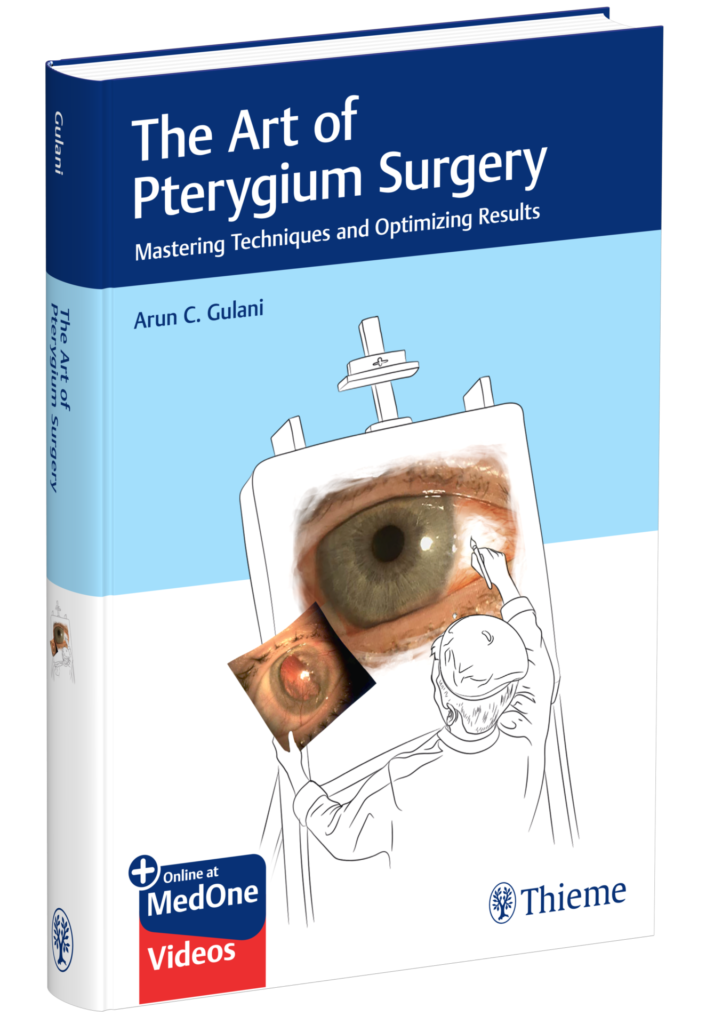
In a detailed personal consultation with advanced technology, Dr. Gulani evaluates not only the anatomical and physiological impacts of dry eyes, but also any associated pathology (like pterygium, pinguecula, or corneal scars) and visual status to then custom-design his treatment and surgical plans to each patient to deliver the best outcome with the safest approach in that patient’s best interest.
Unshakable by industry hype or new technology promises, Dr. Gulani who is always years ahead of his peers worldwide with his international privileges and technology innovations, will perform a thorough consultation and after a detailed diagnostic evaluation, pick among his full range of techniques and technologies (KLEARTM) to include chemically and osmotically balanced artificial tears, meibomian gland recanalization (MGR), temporary or permanent intracanalicular silicon gel lacrimal plugs, amniotic therapy (including Prokera), correcting complications of Lipiflow, Blephex, iLux, and IPL, and even no-stitch surgical techniques either in single, staged or combined management approach for each individual eye.
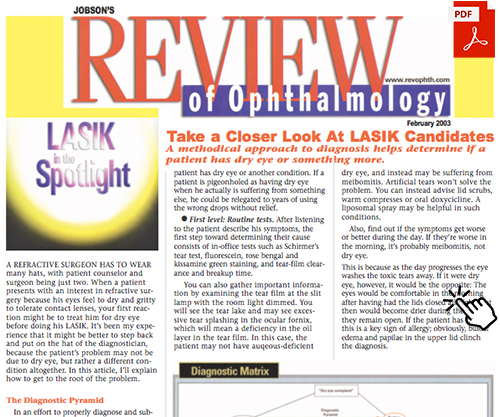
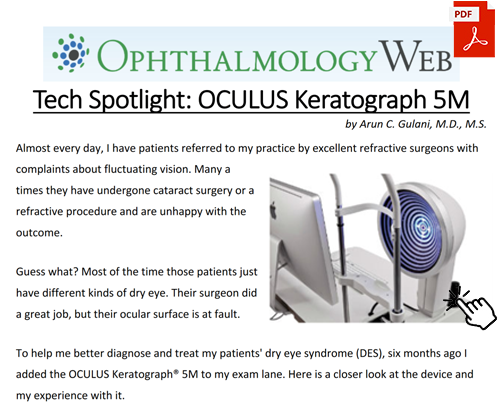
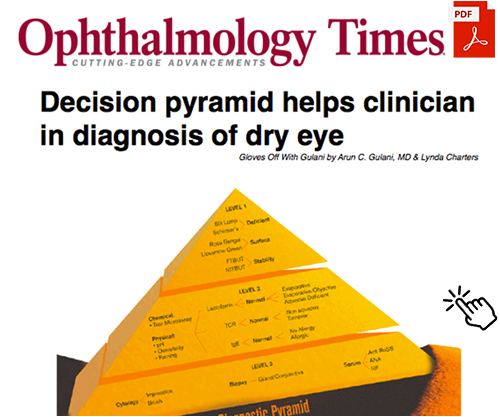
Featured: Read Excerpt from our Patient Jelena’s Book: “Dry Eyes, Causes, and Cures”

There are a plethora of over the counter relief drops and remedies for Dry Eye but it is essential that you have a thorough exam with an expert to have a treatment strategy best tailored for your condition. This is also vital to rule out any local surgeries as a cause ie. Lasik or associated systemic disease of which this could be the first indicator ie. Sjogren’s syndrome, arthritis, thyroid disorders, drug side effects, etc. Additionally, there is a direct correlate between tears and vision, not only naturally but also in converting “Not a Candidate” patients to “Candidates” by correcting their dry eyes and then allowing them an opportunity to qualify for Laser Vision or Premium Cataract surgery to see without glasses and contact lenses.
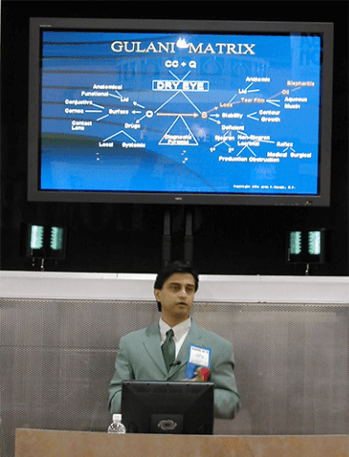
Dr. Gulani teaches DRY EYE management in his instructional courses for eye surgeons globally and provides an in-depth diagnostic evaluation along with a full spectrum of care from medical/pharmaceutical to advanced surgical applications including amniotic membrane surgeries with stem cell transplants for patients with this condition. He approaches Dry Eye as a Specific entity with a Specific cause which warrants a Specific treatment and categorizes the etiology as primary and secondary causes:
- Primary
- Age, Genetic, Hormone related etc.
- Secondary
- Local:
- Disease: i.e. of lacrimal glands, tear ducts, or ocular surface,
- Post Surgical: i.e. after Lasik, Radial Keratotomy, Cataract Surgery, etc.
- Systemic:
- Disease: i.e. Sjorgen syndrome, Hypothyroidism, Collagen Vascular Diseases like Lupus, arthritis, etc.
- Lifestyle: smoking, vaping, excessive digital screen use (computer, cell phone, etc.)
- Drugs: contraceptive pills, hypertension, allergy, chemotherapy, etc
- Local:
Using this dedicated methodology, he has successfully helped people suffering from all levels of dry eyes who travel to our institute from all over the world. He explains that the tear film is actually about 7 microns thick and is made up of three layers:
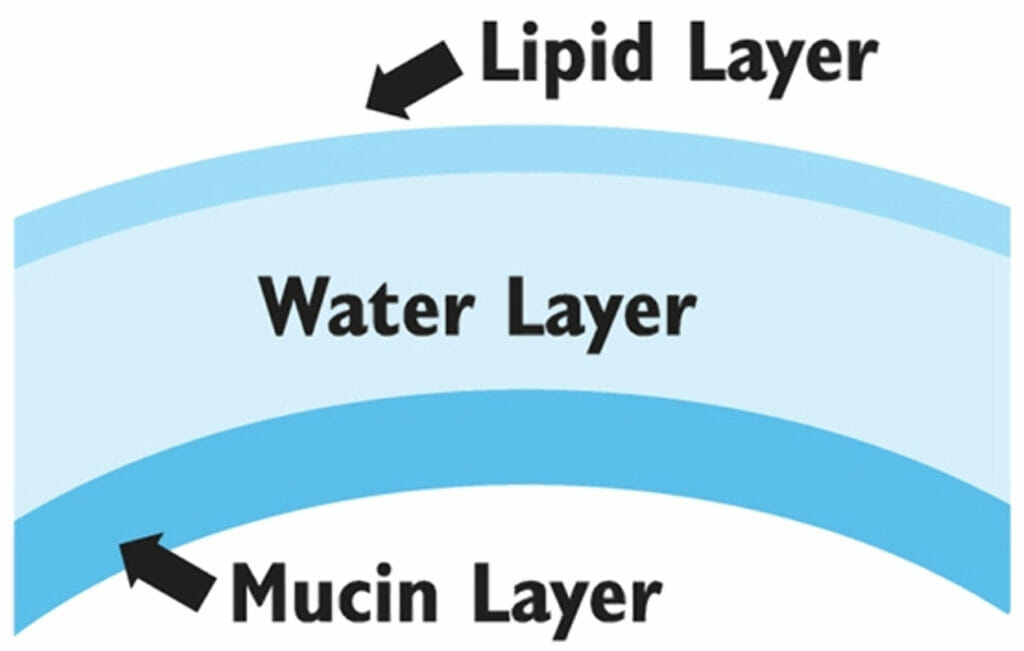
- The Innermost, Mucin Layer (produced by the Conjunctival Goblet cells on the surface of the eye) this layer makes the tear film “Stick” to the eyeball.
- The Middle, Aqueous Layer (produced by the Lacrimal glands which are located on the upper and outer side of your eye socket) is the real Tear Film and contains all of the chemicals and nutrients that are needed for ocular health and vitality.
- The Outermost, Lipid layer (produced by the Meibomian glands) which are arranged along the eyelid margins vertically in rows like “Tooth Paste Tubes” with their “Mouths” opening at the lid margin (close to the eye lashes) actually provides surface tension to the tear film and hence maintains its vertical distribution on the eye despite gravity.
Dr. Gulani classifies Dry eyes at various levels for eye care practitioners based on severity, symptomatology, cause and vision impact.
Essentially though he explains that there are two basic kinds of dry eyes:
- Deficient: Decreased production of one or multiple tear film layers.
- Evaporative: Excessive loss due to anatomical, physiological, and lifestyle impact factors.
Some Pearls:

- The tear film is actually dependent on the nerve sensation of the cornea (that is why people have Dry eyes following a certain kind of Lasik surgery where the nerves get cut during surgery) and inflammatory cycles related to allergy, infections etc.
- The tear film leaves the eye via tear ducts (in each lid) and goes into the nose on a normal basis (remember how some eye drops taste nasty).
The above explanation is Dr. Gulani’s way of simplifying the dry eye concept for all his patients and then he gets to work further investigating the root cause of dry eye and planning an effective treatment regimen within his proprietary m.o.i.s.t.® therapy treatment spectrum.
So lets say someone has a decreased production but good quality of tears, they can have temporary or permanent intra-canalicular punctual plugs (ICSG) inserted into their tear ducts and thereby “Retain” whatever little tears they produce (a Plumbing issue to block the drain since the tap is producing less water so the water remains in the sink for a longer time). This can further be augmented by tear-producing eye drops like Restasis or Xiidra.

If the quantity produced is good but the loss is excessive (Evaporative Dry eyes) then he addresses that abnormal layer effectively with appropriate eye drops, medications and techniques. For example, if the Lipid layer is affected because of the Meibomian glands being blocked by repeated inflammation and allergy, he can detect this problem and actually re-open these glands with a brief, in-office procedure using new technologies he keeps innovating and honing over decades of experience.
With 3 decades of experience in working with dry eye patients from around the world, Dr. Gulani’s clinical acumen along with cutting edge diagnostic technologies including one of the first Oculus Keratographs in the country can detect all levels of dry eyes from quantitative to qualitative whereby he then designs an individual plan of attack for that dry eye patient.
Oral supplements like Omega-3 supplements, Flaxseed oil etc. and also tear enhancing eye drops like Xiidra and ReStasis can also be used along with PH balanced artificial tears.
In more serious cases of dry eyes with associated pathology and complications, Dr. Gulani can raise the bar to perform “No-Stitch” human placenta surgery, transplants etc. Thus, we can see how approaching the dry eye complaint in a systematic manner can actually make sense of the situation, rule out any associated diseases and effectively plan for a customized solution for each individual eye.
The Gulani m.o.i.s.t.® therapy therein identifies the exact kind of dry eye to then custom-design a treatment plan for that individual patient in single or combined and even staged protocols for successful outcomes.

Tear Enhancing Drops
Among Dr. Gulani’s proprietary m.o.i.s.t.® therapy treatments, tear enhancing drops play an important role in increasing pure tear volume either directly or indirectly. These tear enhancing drops are classified firstly on whether they are medicated or nonmedicated and further classified by their chemical (i.e. with or without preservatives) and physical properties (viscosity, osmolarity).

Included in the nonmedicated tear enhancing drops are artificial tears. Based on the physical and chemical status of your tears Dr. Gulani individualizes the selection of various brands (i.e. Refresh, Systane, Retaine, Lacri-Lube, Rohto, Blink) for your particular therapy. All of these lubricant drops provide hydration to the eye to provide relief and protection.
Two of the most commonly used medicated tear enhancing drops are Restasis and Xiidra. Predominately medicated eye drops target inflammation in the eye to relieve feelings of achy, gritty, itchy, and burning eyes. Again, these medications can be used by themselves or with other aspects of the m.o.i.s.t.® therapy approach.
In some more extreme cases there are even prescription lubricants such as Lacrisert that can be inserted in the eye to provide relief for dry eyes for up to 24 hours. This medication dissolves over the course of the day to stabilize and thicken the tear film of the eye.
Patients own blood serum can also be processed and made into drops. Studies have shown that this serum is able to help patients with chronic dry eyes with specific indications more than others.
Lacrimal Plugs
In Dr. Gulani’s proprietary m.o.i.s.t.® therapy lacrimal plugs play an important role in addressing the aqueous (water) layer in the tear film. Lacrimal plugs work by blocking the drainage of tears into the nose thus keeping the patient’s own tears in their eyes for longer.

Dr. Gulani teaches patients and surgeons giving an analogy (*Gulanism) as “think as if your tap is producing less water. You need the water so you stop the sink with a drain stop to retain that water.”
The Gulani lacrimal plug system is classified as:
- Temporary
- Intermediate
- Permanent
In addition to which there are also medicated plugs (such as the Dextensa brand).
Meibomian Gland Recanalization

Among Dr. Gulani’s proprietary m.o.i.s.t.® therapy techniques Meibomian Gland recanalization addresses the lipid (oil) layer of your tear film. Meibomian (“my-boh-mee-an”) glands are 20 – 40 toothpaste tube (slightly crooked though) shaped glands, lined along eye lashes in our eye lids which secrete the oil layer of our tear film to prevent evaporation of our tears too quickly by creating surface tension (making a film of water stay vertical despite gravity).
Blockage, disease or inflammation of these glands results in Meibomian Gland Dysfunction (MGD). You can imagine then that a faulty oil layer can allow our tears to evaporate quickly and cause dry eyes (Evaporative kind of dry eye) and in many cases is associated with lid inflammation (Blepharitis).
Most common causes of MGD include, repeated or incorrectly managed lid inflammations including allergies, gender as in more prevalent in females, advancing age, ethnic background as in Asians have a higher propensity. Wearing eye makeup is another contributing cause of MGD. Eyeliner and other makeup can clog the openings of meibomian glands especially if you don’t thoroughly clean your eyelids and remove all traces of eye makeup before sleep. Wearing contact lenses for especially long durations also is a risk factor. Medical situations can also increase the chances of this infliction and history of arthritis, Sjogrens, Thyroid dysfunction, diabetes etc are important and need control for overall success.
With 3 decades of experience in working with dry eye patients from around the world, Dr. Gulani’s clinical acumen along with cutting edge diagnostic technologies including one of the first Oculus Keratographs in the country can detect all levels of dry eyes from quantitative to qualitative whereby he then designs an individual plan of attack for that dry eye patient. With over 3 Decades of experience Dr. Gulani uses his personally designed instruments to treat Meibomian Gland Dysfunction with:
- One-Step
- Single probe
- Multiple probes
- Staged
- Combination with other treatments
Dr. Gulani has been using Meibomian Gland Recanalization (MGR), as a modified meibomian gland probing (MGP) wherein differential probing performed to the endpoint of recanalization as evidenced by release of trapped meibum and insertion of the marked probe. This technique has successfully treated MGD based dry eyes during m.o.i.s.t.® therapy to the point of even converting them into candidates for laser vision and premium cataract surgery.
Besides an array of technologies like LipiView, LipiFlow, iLux, Tearcare, Blephex and IPL to treat dry eyes, Dr. Gulani’s personal experience in using customized, differential Meibomian Gland recanalization techniques done in-office in less than 10 minutes with a sequential non-cutting probe, and proprietary numbing gel (no painful injections) made in a pharmacy in California has resulted in near 100% success.
This followed by an individually time-planned warm compression of the eyelids and medication protocol of eye drops results in melting and expressing the thickened oil and also changing it chemically to the more user friendly version. No patient has had to undergo repeat MGR treatment because of the role of conscious hygiene and warm compresses that maintains the viability of the meibomian glands long term.
Chalazion

Imagine now that when one or multiple of these meibomian glands are blocked that their secretions (meibum) stagnates in the gland forming a cyst-like lesion known as chalazion (external hordeolum). This is differentiated from a sty (internal hordeolum) which usually represents and infection which is usually more painful and inflamed.
A chalazion therefore presents itself as a bump on the eyelid which in most cases is not painful or inflamed but could present with symptoms ranging from swollen eyelid, to irritation, to even blurry vision in advanced cases.

Primary Treatment:
The age-old treatment of chalazion is to begin with conservative management using warm compresses and steroid based medications which made need surgical I&D (incision and drainage) as a definitive treatment for recalcitrant cases.
Meibomian Gland Recanalization:
The consistent success of our MGR procedure inspired us to develop and apply a “No-Incision Chalazion Expression” (NICETM) technique for recalcitrant chalazia with gratifying results both, objectively and subjectively.
Amniotic Therapy

With nearly 3 decades of pioneering human placental (amniotic membrane) tissue application in the field of eye care, Dr. Gulani has successfully utilized amniotic tissue at all levels of dry eyes including publishing his work by authoring a textbook of ophthalmology sharing his experience with eye surgeons globally.
Dr. Gulani has categorized amniotic use into:
1. Non-Surgical
- Processed Eyedrops (i.e. Regenereyes)
- Self-retained Contact lens (i.e. Prokera, AlphaVision)
2. Surgical
- Freeze-dried graft (i.e. BioTissue AmnioGraft)
- Dehydrated (i.e. Ambiodry)
Dr. Gulani’s continual research and experience enhances his ability to provide the latest, most comprehensive surgical options to his patients. He is a world-renowned leader in the field of Amniotic Membrane Transplantation (AMT). This surgery is used to address:
- Pinguecula
- Pterygium
- Corneal scars
- Dry eyes
- Conjunctivochalasis
The amniotic membrane is derived from a donated human placenta which has been screened and preserved and made commercially available to physicians. It can replace the eye’s surface and temporarily act as a support matrix, helping the eye tissue to heal. In fact Dr. Gulani uses a no-stitch technique using specialized glue.
Dr. Gulani also uses it to heal corneal scars and he has included it in his Corneoplastique® procedure, to improve both vision and the appearance of the eyes.
He has developed unique surgical techniques and designed specialized instruments for these new surgeries. Not surprisingly, he has many grateful and delighted patients. His work has been written about in medical journals and in the news media worldwide.
Dr. Gulani utilizes this rejuvenation and restorative propriety of the human placenta along with its anti-inflammatory and stabilizing property to not only address the dry eye but also rejuvenation and stabilize the ocular surface itself.
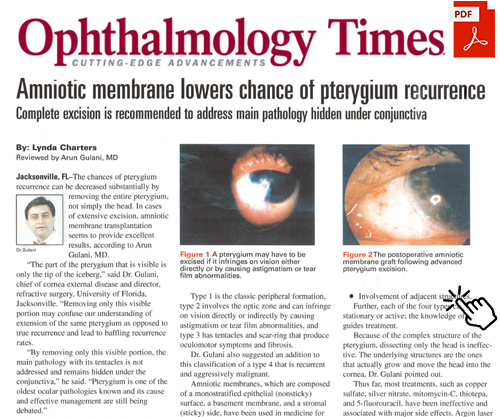
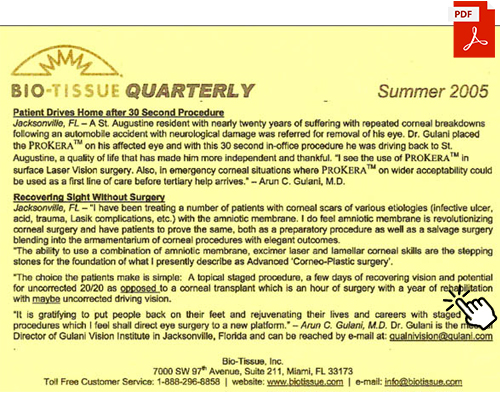
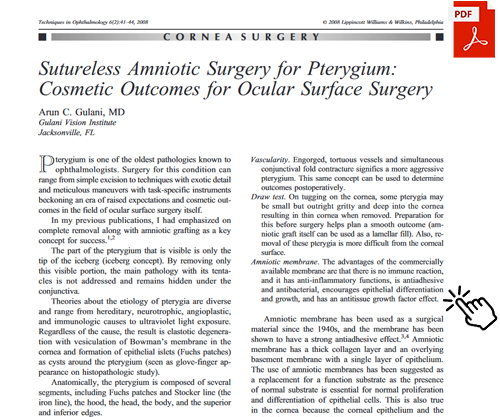
Correcting Failed Therapies

As a world destination for dry eye patients and eye care physicians and surgeons, Dr. Gulani not only helps patients from mild to severe dry eyes but also helps patients who may have undergone failed therapies elsewhere. These therapies could include (poor lacrimal plugs, inadequate meibomian gland recanalization, failed Lipiflow, IPL complications) by uniquely applying his custom tailored approach among the full spectrum of dry eye therapy (m.o.i.s.t.®) to successful outcomes.
Combination Surgery for Dry Eyes
Dry eyes could be associated with a number of pathologies including pinguecula, pterygium, conjunctivochalasis (mechanical dry eye). It could also be an associated problem in patients seeking vision corrective surgery like NexGen Lasik, premium Cataract surgery, keratoconus correction, etc.

Many of these patients are therefore told they are “not a candidate.” Over three decades Dr. Gulani has successfully addressed dry eyes in these patients using his proprietary m.o.i.s.t.® therapy concepts to then proceed with successful pinguecula or pterygium surgery and also turn these “not a candidate” patients into “candidates” for vision corrective surgery like Nex-Gen Lasik or premium Cataract surgery.
So not only can patients suffering from dry eyes be given the opportunity to look good (with pinguecula, pterygium, or red eye surgery) and see good (Nex-Gen Lasik, Cataract) but also those patients who may have had dry eyes as a side effect or complication of vision corrective surgery (i.e. Lasik) have also been successfully helped.
In summary then dry eye therapy (the Gulani m.o.i.s.t.® therapy) can be used to prepare a patient for surgical candidacy and also correct those patients with surgical complications as a combination approach in simultaneous or staged protocols.


